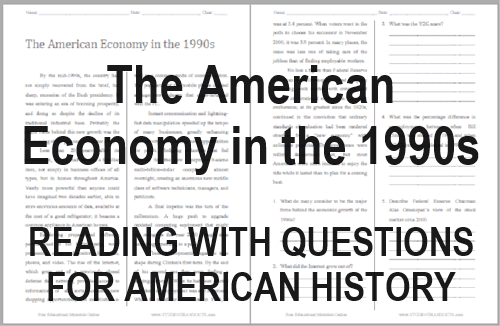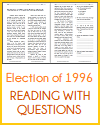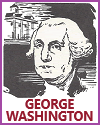| The American Economy in the 1990s Reading with Questions |
|---|
| www.studenthandouts.com ↣ American History ↣ American History Readings |
 By the mid-1990s, the country had not simply recovered from the brief, but sharp, recession of the Bush presidency. It was entering an era of booming prosperity, and doing so despite the decline of its traditional industrial base. Probably the major force behind this new growth was the blossoming of the personal computer (PC).
By the mid-1990s, the country had not simply recovered from the brief, but sharp, recession of the Bush presidency. It was entering an era of booming prosperity, and doing so despite the decline of its traditional industrial base. Probably the major force behind this new growth was the blossoming of the personal computer (PC).
Less than 20 years after its introduction, the PC had become a familiar item, not simply in business offices of all types, but in homes throughout America. Vastly more powerful than anyone could have imagined two decades earlier, able to store enormous amounts of data, available at the cost of a good refrigerator, it became a common appliance in American homes. Employing prepackaged software, people used it for bookkeeping, word processing, or as a depository for music, photos, and video. The rise of the Internet, which grew out of a previously closed defense data network, provided access to information of all sorts, created new shopping opportunities, and established e-mail as a common mode of communication. The popularity of the mobile phone created a huge new industry that cross-fertilized with the PC. Instant communication and lightning-fast data manipulation speeded up the tempo of many businesses, greatly enhancing productivity and creating new opportunities for profit. Fledgling industries that fed demand for the new equipment became multi-billion-dollar companies almost overnight, creating an enormous new middle class of software technicians, managers, and publicists. A final impetus was the turn of the millennium. A huge push to upgrade outdated computing equipment that might not recognize the year 2000 brought data technology spending to a peak. These developments began to take shape during Clinton's first term. By the end of his second one they were fueling a surging economy. When he had been elected president, unemployment was at 7.4 percent. When he stood for re-election in 1996, it was at 5.4 percent. When voters went to the polls to choose his successor in November 2000, it was 3.9 percent. In many places, the issue was less one of taking care of the jobless than of finding employable workers. No less a figure than Federal Reserve Chairman Alan Greenspan viewed a rapidly escalating stock market with concern and warned of "irrational exuberance." Investor exuberance, at its greatest since the 1920s, continued in the conviction that ordinary standards of valuation had been rendered obsolete by a "new economy" with unlimited potential. The good times were rolling dangerously fast, but most Americans were more inclined to enjoy the ride while it lasted than to plan for a coming bust. Click here to print. Answer Key: (1) personal computer (PC); (2) a previously closed defense data network; (3) fear that outdated computing equipment might not recognize the year 2000; (4) decreased 2%; (5) viewed a rapidly escalating stock market with concern and warned of "irrational exuberance." |
 |  |  |  |  |  |
| UNIT I: | Early America | UNIT IX: | Discontent and Reform | ||
| UNIT II: | Colonial Period | UNIT X: | War, Prosperity, and Depression | ||
| UNIT III: | American Revolution | UNIT XI: | New Deal and World War II | ||
| UNIT IV: | New National Government | UNIT XII: | Postwar America | ||
| UNIT V: | Westward Expansion | UNIT XIII: | Decades of Change | ||
| UNIT VI: | Sectional Conflict | UNIT XIV: | New Conservatism | ||
| UNIT VII: | Civil War and Reconstruction | UNIT XV: | Into the Twenty-first Century | ||
| UNIT VIII: | Growth and Transformation | UNIT XVI: | Polarization and Deglobalization |
| www.studenthandouts.com ↣ American History ↣ American History Readings |








